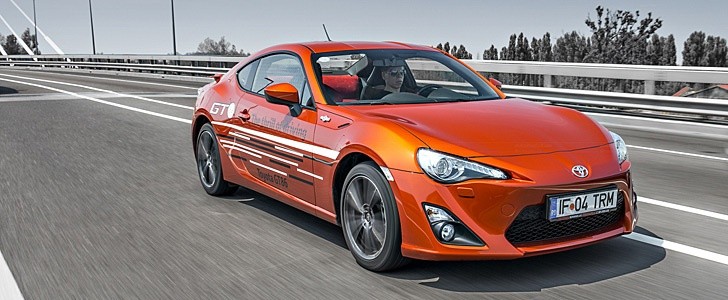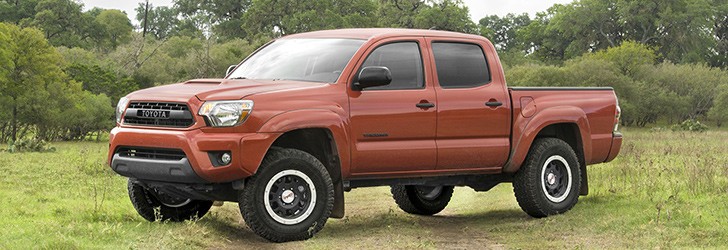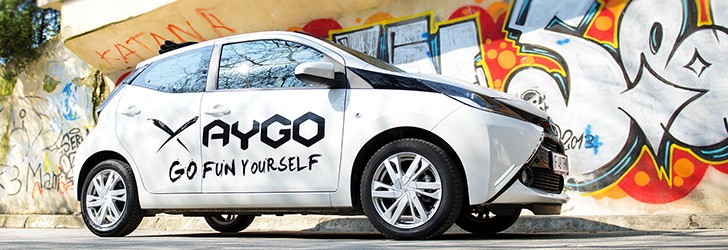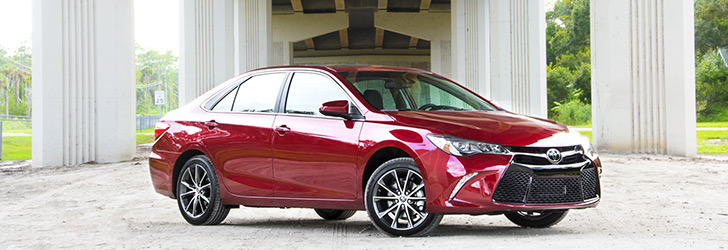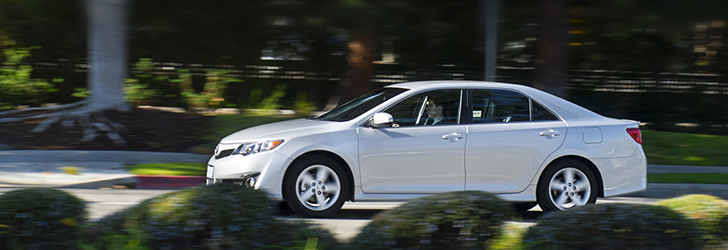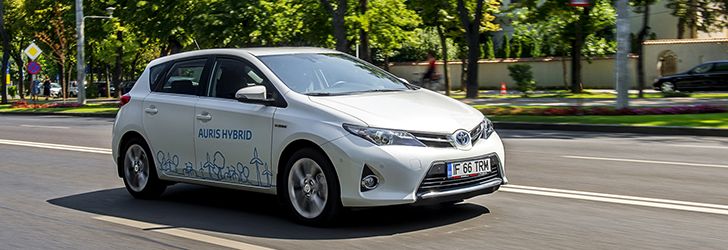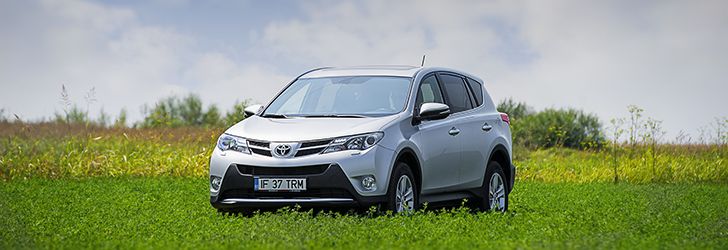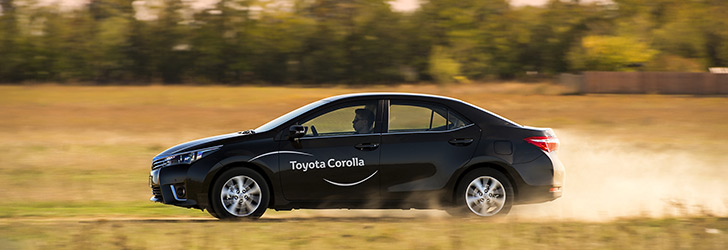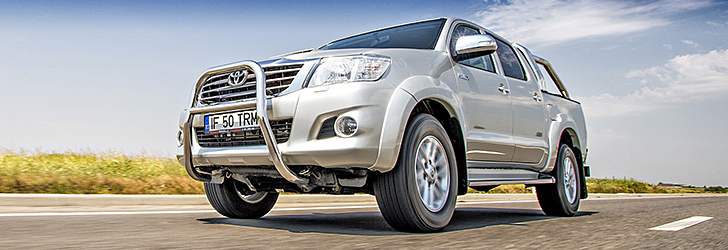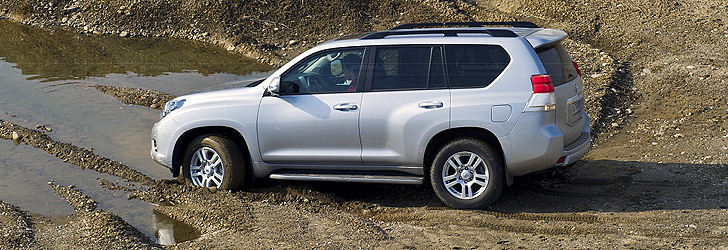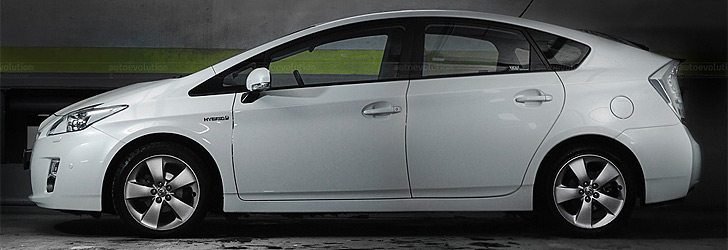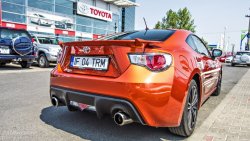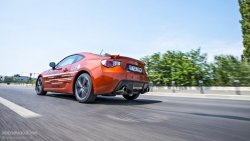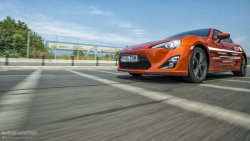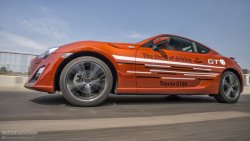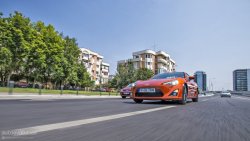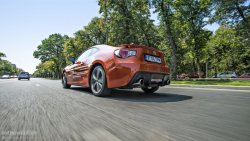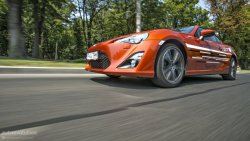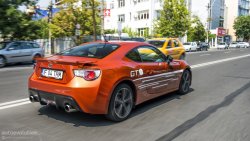TOYOTA GT 86 Review
OUR TEST CAR: TOYOTA GT 86 Manual 2012
When Lamborghini builds a car, it makes it extra wide and gifts it with four very fat pieces of rubber so that it sticks to the road at monumental speeds. When Toyota built the GT 86, the company did the exact opposite.
It fitted the car with relatively skinny tires and din’t lower it to a point that would drive its drive crazy on less than perfect roads, even though its center of gravity was brought as close to the road as possible.
Toyota did all this to make sure that the GT 86 is a machine that offers pure driving pleasure (please excuse the cliché, but this is true), but don’t think that Lambo and other supercar producers are the only ones that cheat when they build their vehicles, compromising usability for stability. For the sake of comparison, before we move on to talk about the GT 86, we'll give you one example of a car that's not cheating: the Pagani Huayra, which also uses all-round active aerodynamics to stay on the road at high speeds.
The Japanese automaker cheated too, as it used very little soundproofing, in order to both allow the driver to feel everything that’s going on and keep the weight down.
Don’t get us wrong, it’s not like you’re in a racecar and you hear the gearing working as you accelerate, but you do feel the LSD at play as you engage first gear and the fact that the wheel wells are made of paper-thin material means that you’ll feel everything that’s going on under the car.
However, neither the suspension, nor the seats, use extremely hard setup and even though the latter could be a tad softer and a bit wider, you can use the car everyday or for long trips (we must also thank the ground clearance of 5.1 inches OR 130 mm for this), but you do have to be open to compromises.
The GT 86 is, according to its creators, the most compact four-seater sports car in the world and while, like in most cars that use the 2+2 configuration, you can’t actually use the back seats, this means that you get a package that os 4.2 meters (167 inches) long, 1.77 m (101 inches) wide and just 1.28 meters (50.6 inches) tall and manages to tip the scales at around 1,250 kg (2,755 lbs).
The engineers choose to stray a bit from the theoretical ideal weight distribution of 50:50, using a slightly front-biased setup of 53:47, in order to allow the car to respond better to the driver’s inputs.
Up front, we have a setup that uses MacPherson struts and at the back the gt 86 comes with a double wishbone configuration. Toyota engineers chose to make the spring rates a tad softer than those on the Subaru BRZ sister car, in order to allow the car to roll slightly during the turn-in phase, so that, again, it responds quicker to the driver’s inputs.
So, the weight has been kept down and the center of gravity has been lowered as much as possible (for example, the driving position comes with the lowest hip point in Toyota’s history), but to truly be able to bring the car closer to the road, the engine had to be mounted low too.
Thus, the horizontally-opposed configuration of Subaru’s 2.0-liter four-cylinder was perfect. The flat four was modified starting from the bore and stroke, with both now standing at... you guessed it... 86 mm. Toyota stepped in with its D-4S technology, which combines direct and port injection, with the final touch being brought by a high compression ratio of 12.5:1.
The engine now produces 200 hp, which come to your right foot at 7,000 rpm and a peak torque of 205 Nm (151 lb-ft), which arrives 400 rpm earlier. The flat four works with a short-throw six-speed manual (you can also get an automatic, but we wouldn’t recommend it), which sends the power to the rear wheels using a torque-sensitive limited slip differential (Torsen LSD).
For the connection to the road, the engineers chose to ditch the usual setup, which includes wide, super-sticky go-fast tires, for some rubber borrowed from the Prius. The GT 86 uses 215/45 R17 tires, so not only are they skinny (for a sports car, of course), but they also let go earlier than performance tires. As you’ll be able to read in the “Open Road” chapter, this was an excellent, choice, as it allows the driver to play with the car.
You can’t drive a car like the GT 86 and not see its mechanical goodies as the most important features, so we’ll have to ask you to forgive us for focusing on items such as the torque-sensitive limited slip differential (Torsen LSD), the six-speed manual with a short-throw shifter and the handbrake lever, which is extremely handy and bites the rear axle like a Cobra (no pun intended).
Moving past these racer obsessions, we’ll tell you that the GT 86 comes with a nice standard specification, which includes features like HID headlights with special LED daytime running lights, keyless entry and engine start system (we have to mention that the steering column still features the hole for the key, which is now covered in rubber, while the start button is placed on the center console).
In addition to that, you also get a light sensor, a dual-zone climate control system, heated front seats, a touchscreen infotainment system, which, as with many Japanese cars, is mediocre, Bluetooth and USD connectivity, cruise control, heights and depth adjustable steering wheel, a leather finish for the steering wheel and handbrake lever, power windows, as well as an upholstery that mixes leather with Alcantara.
The last feature manages to create quite a nice grip, holding you inside your seat during hooning sessions. It perfectly suits the character of the car, although we expect the large Alcantara surfaces won’t age well.
Our test was also gifted with the very few optional extras available, meaning the Toyota Touch & Go navigation module and the metallic paint, in this case Orange.
Neither one of the Toyobaru project’s three road incarnations was tested by an official safety organization, with the exception of the Subaru BRZ, which was subjected to a crash test by the Australian New Car Assessment Program (ANCAP).
The BRZ comes with two front airbags, side airbags, side curtain airbags, as well as a driver knee airbag, Antilock brakes (ABS), electronic brake distribution (EBD) and electronic stability control (ESC), as standard features.
The coupe got a five-star rating, earning 14.97 out of 16 points in the offset crash test. The passenger cell kept its shape during the impact. However, there was a slight risk of serious leg injury for the driver, as well as a slight risk of serious chest injury for the passenger.
As for the side impact crash test results of the car, the BRZ received 15.43 out of 16 points, but there was a slight risk of serious chest injury for the driver,
On the road, the normal (read: not supersport) tires of the car will make the back step out sooner, but the electronic nannies manage to keep things under control and, once you turn these off, the oversteer is linear and predictable.
As for the brakes, these provide impressive stopping power, despite looking a bit undersized. We have to mention that the low overall weight of the car does have an important contribution to this.
The Toyota GT 86 definitely isn’t a car for the masses. And making the aforementioned statement might make us seem like team Obvious, we have to explain that it appeals to a niche within a niche. You see, we were already talking about the performance car-driving masses. The GT 86 has had the unfortunate fate of coming to the world in an era when the hot hatch class is one of the most effervescent segments in the car industry.
And it’s hot hatches that the GT 86 should fear the most. In the real world, you don’t get to play on the GT 86’ field very often. This is a car that’s mean for drifting, a car that can teach anybody about what performance cornering means, but on public roads people that drive fast cars usually get to enjoy straight line acceleration and this is where the GT 86 loses to hot hatches.
It’s also a tad more expensive than many hot hatches, with our test car’s price of EUR34,338 (the prices start at EUR32,800) placing it head to head with some of the most expensive representatives of the hot hatch segment.
In the US, its Scion FR-S sister model starts at $26,022, which pits it against cars like the V6-powered Camaro and Mustang. Somehow, the choice for Americans seems easier, as the FR-S is left trailing the pony cars’ trails on the straight but butchers them through the bends, whereas in Europe it also gets the advantage of being the most affordable sports car by a hefty margin, but it is somehow difficult to choose a sports car that can easily be overtaken by some pumped-up hatchbacks on the straights.
However, the car itself is something the industry needed. First of all, like we said, in Europe sports cars start at prices that play in the 40 to 50 thousand Euro league, something that’s incredibly difficult to touch by most young enthusiastic drivers.
Pricing aside, this is a creation that uses the classic sports car recipe and ticks all the right boxes for a proper track day machine. It’s got “pure” written all over it and maybe the most impressive fact about it is that it forgives you for mistakes behind the wheel with the same ease that it lets its back end let go to allow you to have fun. This is a superb piece of driving machinery. It’s like the combination between a mechanical watch and a crossbow
In fact, fun is both a huge asset for the GT 86 and also a controversial word. It is a key asset of the car thanks to the fact that Toyota’s creation manages to offer oversteering good times in an era when every new generation of a sports car makes it offer more grip and less powersliding potential, so that it appeals to a wider audience. And fun is a controversial term to use for the GT 86 due to the car’s overall feeling - it does have all the right technical assets, makes perfect use of them and offers you plenty of good times, but somehow it doesn’t manage to be 100 percent as crazy as certain hot hatches.
And since we spent quite some time comparing it with go-fast hatchbacks, we have to tell you that it beats these in the fuel efficiency race by quite a margin. If you take a look at out test drive fuel consumption figures, you really wouldn’t say that they belong to a sports car. To be more precise, when we didn’t wonder to far from the speed limits, we got 10 l/100 km (23.5 mpg) inside the city and 8.7 l/100 km (27 mpg) on the open road. Of course, the values can climb much higher if you throw a cigarette under the pedal on the right and use this to put it out, but this is another story.
If we look at it as a “normal” car, one that you also use for A to B travels where no piece of the rear tires is turned into smoke, the GT 86 would need some extra sound proofing and superior cabin materials to be able to convince customers to pay close to EUR35,000 for it.
We’re curious to see if Toyota will address these issues, especially since rumors floating around the web indicate that what we’ve seen so far is just the beginning of the Toyobaru project. The two companies are expected to be preparing an even more powerful version of the cars and who knows, maybe they’ll also add a touch of refinement (why not a special trim level?) to make it more appealing. Will the extra soundproofing will the fun by adding weight or dampening the sensations or will the premium materials bring the price up too much and make the car pointless? Not if they get it right and certain models from the past show us that they certainly can.
It fitted the car with relatively skinny tires and din’t lower it to a point that would drive its drive crazy on less than perfect roads, even though its center of gravity was brought as close to the road as possible.
Toyota did all this to make sure that the GT 86 is a machine that offers pure driving pleasure (please excuse the cliché, but this is true), but don’t think that Lambo and other supercar producers are the only ones that cheat when they build their vehicles, compromising usability for stability. For the sake of comparison, before we move on to talk about the GT 86, we'll give you one example of a car that's not cheating: the Pagani Huayra, which also uses all-round active aerodynamics to stay on the road at high speeds.
The Japanese automaker cheated too, as it used very little soundproofing, in order to both allow the driver to feel everything that’s going on and keep the weight down.
Don’t get us wrong, it’s not like you’re in a racecar and you hear the gearing working as you accelerate, but you do feel the LSD at play as you engage first gear and the fact that the wheel wells are made of paper-thin material means that you’ll feel everything that’s going on under the car.
However, neither the suspension, nor the seats, use extremely hard setup and even though the latter could be a tad softer and a bit wider, you can use the car everyday or for long trips (we must also thank the ground clearance of 5.1 inches OR 130 mm for this), but you do have to be open to compromises.
The GT 86 is, according to its creators, the most compact four-seater sports car in the world and while, like in most cars that use the 2+2 configuration, you can’t actually use the back seats, this means that you get a package that os 4.2 meters (167 inches) long, 1.77 m (101 inches) wide and just 1.28 meters (50.6 inches) tall and manages to tip the scales at around 1,250 kg (2,755 lbs).
The engineers choose to stray a bit from the theoretical ideal weight distribution of 50:50, using a slightly front-biased setup of 53:47, in order to allow the car to respond better to the driver’s inputs.
Up front, we have a setup that uses MacPherson struts and at the back the gt 86 comes with a double wishbone configuration. Toyota engineers chose to make the spring rates a tad softer than those on the Subaru BRZ sister car, in order to allow the car to roll slightly during the turn-in phase, so that, again, it responds quicker to the driver’s inputs.
So, the weight has been kept down and the center of gravity has been lowered as much as possible (for example, the driving position comes with the lowest hip point in Toyota’s history), but to truly be able to bring the car closer to the road, the engine had to be mounted low too.
Thus, the horizontally-opposed configuration of Subaru’s 2.0-liter four-cylinder was perfect. The flat four was modified starting from the bore and stroke, with both now standing at... you guessed it... 86 mm. Toyota stepped in with its D-4S technology, which combines direct and port injection, with the final touch being brought by a high compression ratio of 12.5:1.
The engine now produces 200 hp, which come to your right foot at 7,000 rpm and a peak torque of 205 Nm (151 lb-ft), which arrives 400 rpm earlier. The flat four works with a short-throw six-speed manual (you can also get an automatic, but we wouldn’t recommend it), which sends the power to the rear wheels using a torque-sensitive limited slip differential (Torsen LSD).
For the connection to the road, the engineers chose to ditch the usual setup, which includes wide, super-sticky go-fast tires, for some rubber borrowed from the Prius. The GT 86 uses 215/45 R17 tires, so not only are they skinny (for a sports car, of course), but they also let go earlier than performance tires. As you’ll be able to read in the “Open Road” chapter, this was an excellent, choice, as it allows the driver to play with the car.
You can’t drive a car like the GT 86 and not see its mechanical goodies as the most important features, so we’ll have to ask you to forgive us for focusing on items such as the torque-sensitive limited slip differential (Torsen LSD), the six-speed manual with a short-throw shifter and the handbrake lever, which is extremely handy and bites the rear axle like a Cobra (no pun intended).
Moving past these racer obsessions, we’ll tell you that the GT 86 comes with a nice standard specification, which includes features like HID headlights with special LED daytime running lights, keyless entry and engine start system (we have to mention that the steering column still features the hole for the key, which is now covered in rubber, while the start button is placed on the center console).
In addition to that, you also get a light sensor, a dual-zone climate control system, heated front seats, a touchscreen infotainment system, which, as with many Japanese cars, is mediocre, Bluetooth and USD connectivity, cruise control, heights and depth adjustable steering wheel, a leather finish for the steering wheel and handbrake lever, power windows, as well as an upholstery that mixes leather with Alcantara.
The last feature manages to create quite a nice grip, holding you inside your seat during hooning sessions. It perfectly suits the character of the car, although we expect the large Alcantara surfaces won’t age well.
Our test was also gifted with the very few optional extras available, meaning the Toyota Touch & Go navigation module and the metallic paint, in this case Orange.
Neither one of the Toyobaru project’s three road incarnations was tested by an official safety organization, with the exception of the Subaru BRZ, which was subjected to a crash test by the Australian New Car Assessment Program (ANCAP).
The BRZ comes with two front airbags, side airbags, side curtain airbags, as well as a driver knee airbag, Antilock brakes (ABS), electronic brake distribution (EBD) and electronic stability control (ESC), as standard features.
The coupe got a five-star rating, earning 14.97 out of 16 points in the offset crash test. The passenger cell kept its shape during the impact. However, there was a slight risk of serious leg injury for the driver, as well as a slight risk of serious chest injury for the passenger.
As for the side impact crash test results of the car, the BRZ received 15.43 out of 16 points, but there was a slight risk of serious chest injury for the driver,
On the road, the normal (read: not supersport) tires of the car will make the back step out sooner, but the electronic nannies manage to keep things under control and, once you turn these off, the oversteer is linear and predictable.
As for the brakes, these provide impressive stopping power, despite looking a bit undersized. We have to mention that the low overall weight of the car does have an important contribution to this.
The Toyota GT 86 definitely isn’t a car for the masses. And making the aforementioned statement might make us seem like team Obvious, we have to explain that it appeals to a niche within a niche. You see, we were already talking about the performance car-driving masses. The GT 86 has had the unfortunate fate of coming to the world in an era when the hot hatch class is one of the most effervescent segments in the car industry.
And it’s hot hatches that the GT 86 should fear the most. In the real world, you don’t get to play on the GT 86’ field very often. This is a car that’s mean for drifting, a car that can teach anybody about what performance cornering means, but on public roads people that drive fast cars usually get to enjoy straight line acceleration and this is where the GT 86 loses to hot hatches.
It’s also a tad more expensive than many hot hatches, with our test car’s price of EUR34,338 (the prices start at EUR32,800) placing it head to head with some of the most expensive representatives of the hot hatch segment.
In the US, its Scion FR-S sister model starts at $26,022, which pits it against cars like the V6-powered Camaro and Mustang. Somehow, the choice for Americans seems easier, as the FR-S is left trailing the pony cars’ trails on the straight but butchers them through the bends, whereas in Europe it also gets the advantage of being the most affordable sports car by a hefty margin, but it is somehow difficult to choose a sports car that can easily be overtaken by some pumped-up hatchbacks on the straights.
However, the car itself is something the industry needed. First of all, like we said, in Europe sports cars start at prices that play in the 40 to 50 thousand Euro league, something that’s incredibly difficult to touch by most young enthusiastic drivers.
Pricing aside, this is a creation that uses the classic sports car recipe and ticks all the right boxes for a proper track day machine. It’s got “pure” written all over it and maybe the most impressive fact about it is that it forgives you for mistakes behind the wheel with the same ease that it lets its back end let go to allow you to have fun. This is a superb piece of driving machinery. It’s like the combination between a mechanical watch and a crossbow
In fact, fun is both a huge asset for the GT 86 and also a controversial word. It is a key asset of the car thanks to the fact that Toyota’s creation manages to offer oversteering good times in an era when every new generation of a sports car makes it offer more grip and less powersliding potential, so that it appeals to a wider audience. And fun is a controversial term to use for the GT 86 due to the car’s overall feeling - it does have all the right technical assets, makes perfect use of them and offers you plenty of good times, but somehow it doesn’t manage to be 100 percent as crazy as certain hot hatches.
And since we spent quite some time comparing it with go-fast hatchbacks, we have to tell you that it beats these in the fuel efficiency race by quite a margin. If you take a look at out test drive fuel consumption figures, you really wouldn’t say that they belong to a sports car. To be more precise, when we didn’t wonder to far from the speed limits, we got 10 l/100 km (23.5 mpg) inside the city and 8.7 l/100 km (27 mpg) on the open road. Of course, the values can climb much higher if you throw a cigarette under the pedal on the right and use this to put it out, but this is another story.
If we look at it as a “normal” car, one that you also use for A to B travels where no piece of the rear tires is turned into smoke, the GT 86 would need some extra sound proofing and superior cabin materials to be able to convince customers to pay close to EUR35,000 for it.
We’re curious to see if Toyota will address these issues, especially since rumors floating around the web indicate that what we’ve seen so far is just the beginning of the Toyobaru project. The two companies are expected to be preparing an even more powerful version of the cars and who knows, maybe they’ll also add a touch of refinement (why not a special trim level?) to make it more appealing. Will the extra soundproofing will the fun by adding weight or dampening the sensations or will the premium materials bring the price up too much and make the car pointless? Not if they get it right and certain models from the past show us that they certainly can.
THE END
12
Our TOYOTA Testdrives:
Photo gallery (86)
